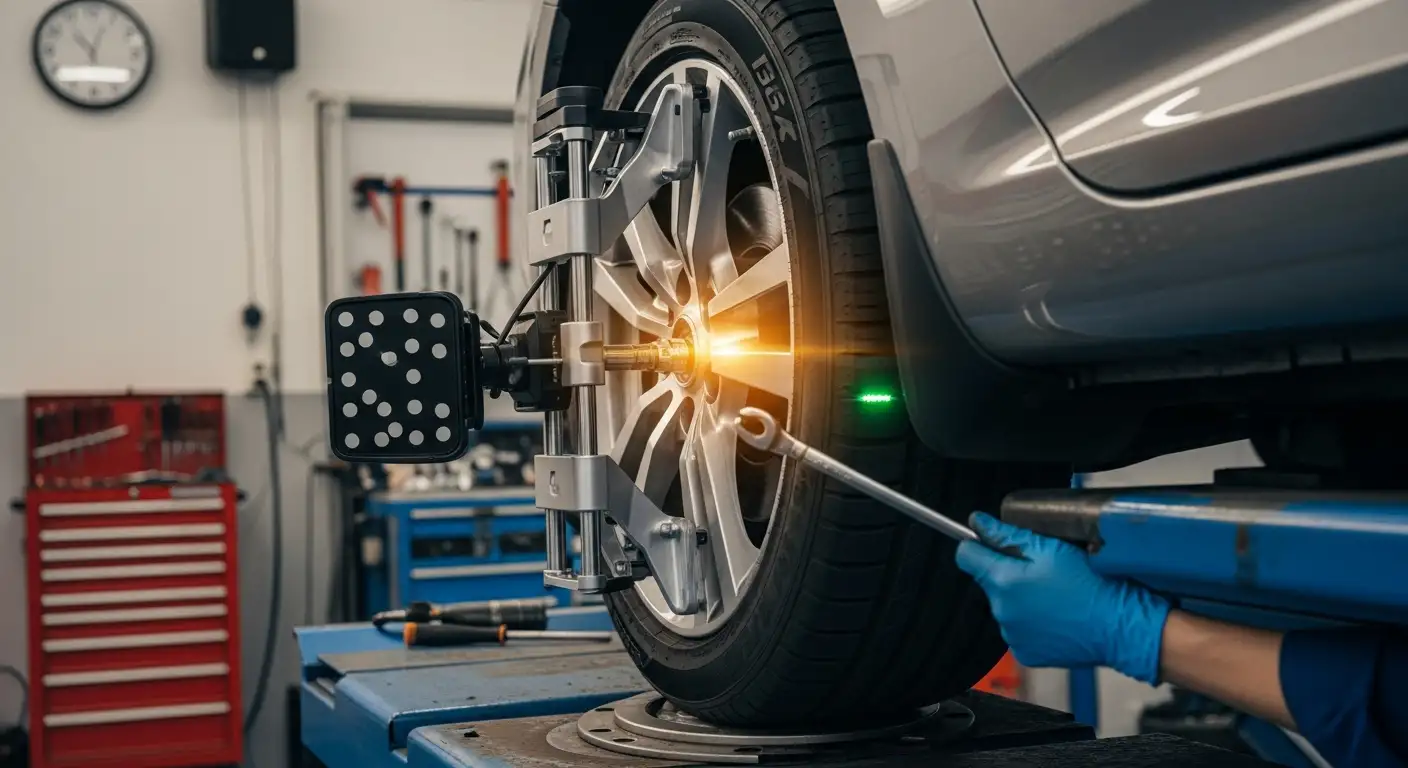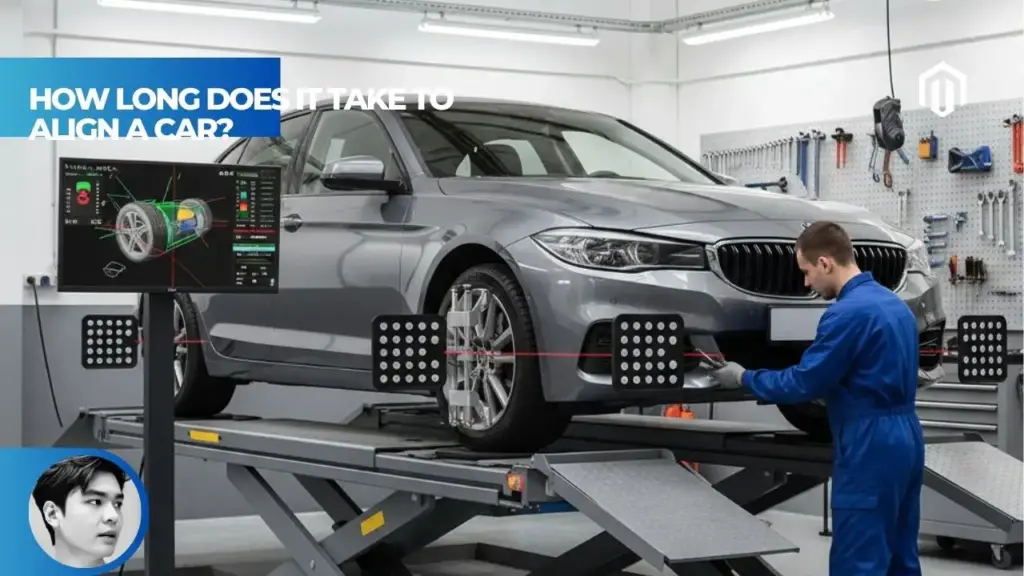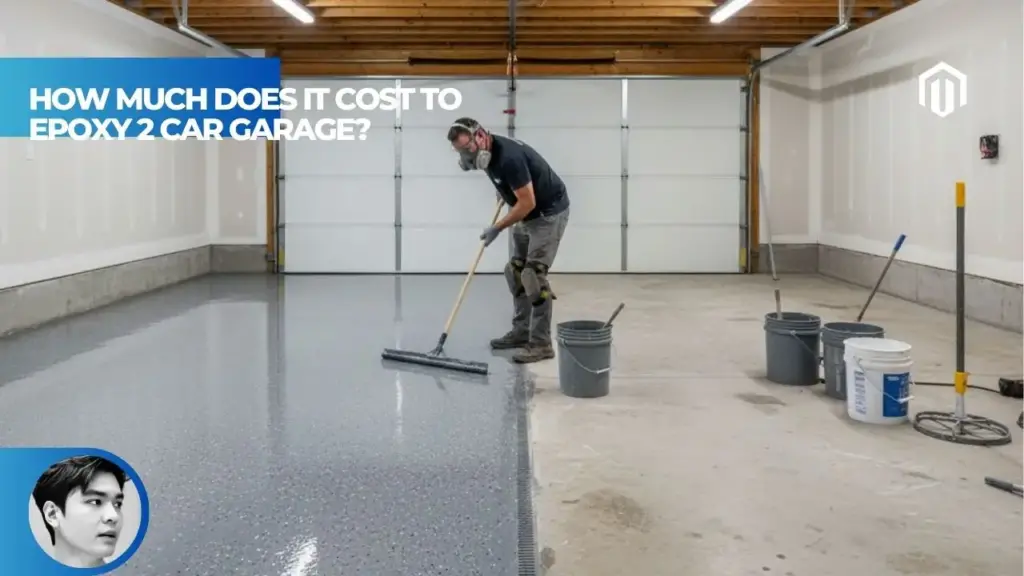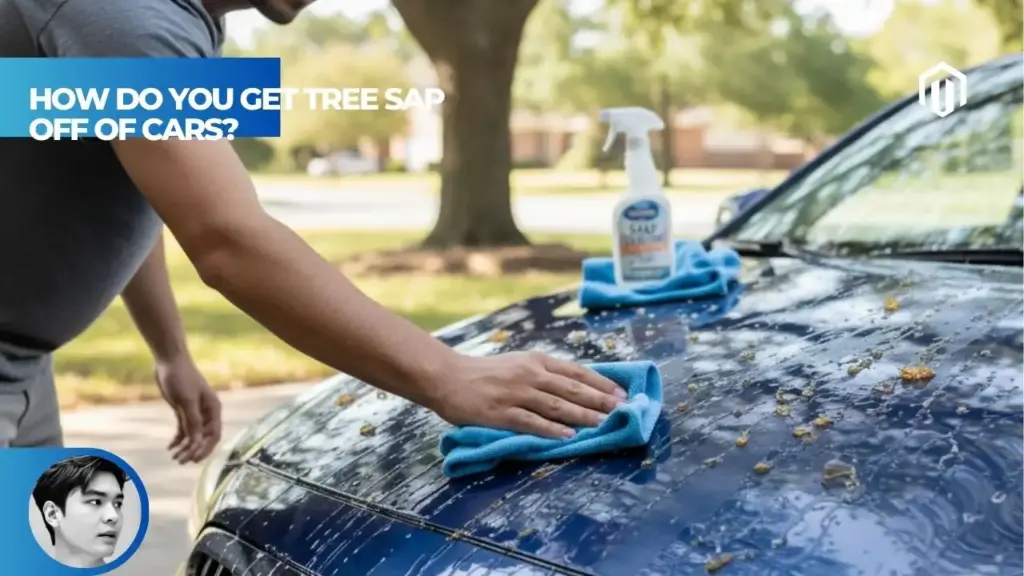You may also like:
- 【Explained】How Long Does It Take to Inspect a Car? The Factors That Influence Time
- 【Explained】How Long Does It Take to Buy a Car? A Step-by-Step Timeline
- 【Explained】How Long Does It Take to Replace a Car Battery? (A Full Breakdown)
- 【Explained】Why Does My Car Make a Noise When I Turn? 5 Causes
- 【Explained】How Much Power Steering Fluid Does a Car Need? (Capacity for Top-Off vs. Flush)
A standard car alignment takes between 30 minutes to 1 hour under normal circumstances, with two-wheel alignments averaging 30-45 minutes and four-wheel alignments requiring 45-90 minutes. However, modern vehicles equipped with ADAS (Advanced Driver-Assistance Systems) may need an additional 30-60 minutes for sensor calibration, while complications like rusted parts can extend service time to 2 hours or more.

Average Time for a Car Alignment Service
Understanding typical alignment durations helps you plan your schedule and set realistic expectations when visiting a service center. The time investment varies significantly based on service type and vehicle complexity.
How Long is a Wheel Alignment Service
A wheel alignment service encompasses more than just adjusting your wheels. The complete process includes initial inspection, mounting the vehicle on specialized equipment, making precise adjustments, and performing quality checks. According to industry data, standard alignment services complete within 45-60 minutes for most passenger vehicles[1].
Service centers with modern laser alignment equipment can perform basic adjustments more quickly than shops using older technology. However, faster doesn’t always mean better—experienced technicians at Autvex recommend allowing adequate time for thorough service rather than rushing through critical adjustments that affect vehicle safety and tire longevity.
30-Minute Wheel Alignment (Quick Services)
Express alignments completing in 30 minutes typically involve simple front-end adjustments on vehicles with minimal misalignment. These quick services work best for newer vehicles requiring minor toe adjustments after routine maintenance or tire rotation. Modern alignment machines with real-time adjustment displays enable technicians to achieve precise settings rapidly.
Quick alignments suit situations where preliminary inspection confirms all suspension components are in good condition and adjustment bolts move freely. However, rushing an alignment to save time risks overlooking underlying issues that could worsen over time.
One-Hour Wheel Alignment (Standard Duration)
The industry-standard one-hour service allows time for comprehensive inspection, adjustment, and verification. This timeframe accommodates most vehicles requiring moderate corrections to camber, caster, and toe angles. Professional shops typically allocate 60 minutes for standard four-wheel alignments to ensure thoroughness[2].
During this hour, technicians can address multiple alignment angles, make fine adjustments, and perform test drives to verify corrections. This duration provides buffer time for unexpected minor complications without rushing the critical adjustment process.
Alignment Service Duration by Type
Different alignment types require varying time investments based on the number of wheels adjusted and complexity of the suspension system.
How Long Does a 2-Wheel Alignment Take
Two-wheel or front-end alignments focus exclusively on the front wheels, making them quicker to complete. These services typically finish in 30-45 minutes for standard passenger vehicles. The process involves adjusting toe, camber, and caster angles on the front suspension while ensuring the rear thrust angle remains within specifications.
Front-wheel drive vehicles often only require two-wheel alignments since their rear suspensions feature non-adjustable solid axles. This simpler configuration reduces service time while still addressing the primary alignment angles affecting tire wear and handling.
How Long Does a 4-Wheel Alignment Take
Four-wheel alignments require 45-90 minutes due to additional rear wheel adjustments. Modern vehicles with independent rear suspensions need all four wheels aligned to ensure proper thrust angle and vehicle tracking. The technician must adjust toe and sometimes camber on rear wheels, doubling the number of measurements and adjustments required.
All-wheel drive vehicles and those with complex suspension systems particularly benefit from four-wheel alignments. The extra time investment ensures all wheels work together harmoniously, preventing premature tire wear and improving vehicle stability.
Car Alignment Process Steps and Timing
Understanding each step helps explain why alignments require specific timeframes and what technicians accomplish during your wait.
What Does a Car Alignment Service Include
A comprehensive alignment service involves multiple stages, each requiring precision and attention to detail. The process begins with pre-alignment inspection, checking tire pressure, and examining suspension components for wear or damage.
| Process Step | Time Required | Activities Performed |
|---|---|---|
| Initial Inspection | 5-10 minutes | Check suspension, steering components, tire condition |
| Vehicle Setup | 5-10 minutes | Mount on rack, attach sensors, input specifications |
| Measurement | 10-15 minutes | Record current alignment angles, identify deviations |
| Adjustment | 15-30 minutes | Correct toe, camber, caster angles to specifications |
| Verification | 5-10 minutes | Re-measure, fine-tune, ensure within tolerances |
| Test Drive | 5-10 minutes | Verify straight tracking, no pulling, proper feel |
Setting Up Alignment Rack
Mounting the vehicle properly on the alignment rack takes 5-10 minutes but proves crucial for accurate measurements. Technicians must ensure the vehicle sits level, attach precision sensors or targets to each wheel, and input specific vehicle information into the alignment computer.
Modern alignment racks use cameras or lasers to measure wheel angles with accuracy to 0.01 degrees[3]. Proper setup prevents measurement errors that could lead to incorrect adjustments and continued alignment problems.
Adjusting Camber, Caster, and Toe
The actual adjustment process represents the alignment’s core, requiring 15-30 minutes depending on how far specifications deviate. Toe adjustments—the angle wheels point relative to vehicle centerline—typically prove simplest, involving tie rod adjustments. Camber (wheel tilt when viewed from front) and caster (steering axis angle) adjustments often require loosening multiple suspension bolts.
Each adjustment affects others, requiring iterative corrections to achieve all specifications simultaneously. Experienced technicians understand these relationships, reducing adjustment time while ensuring precision.
Test Drive After Alignment
Post-alignment test drives verify proper vehicle tracking and identify any remaining issues. This 5-10 minute road test confirms the steering wheel sits centered, the vehicle doesn’t pull, and handling feels normal. Quality shops always include test drives as standard procedure, catching problems before customers leave.
Test drives also allow technicians to ensure no unusual noises developed during adjustment and that all components were properly tightened. This final quality check prevents return visits and ensures customer satisfaction.
Steering Angle Sensor Reset
Modern vehicles equipped with electronic stability control require steering angle sensor calibration after alignment. This sensor tells the vehicle’s computer the steering wheel’s position, enabling proper operation of stability control, traction control, and ADAS features. The reset process adds 5-10 minutes using diagnostic tools.
Failure to reset the steering angle sensor can trigger warning lights and disable safety systems. Autvex technicians emphasize this often-overlooked step’s importance for maintaining modern vehicle safety features.
Tire Alignment vs Wheel Alignment
While often used interchangeably, “tire alignment” and “wheel alignment” describe the same service. The confusion arises because the adjustments actually occur at suspension components, not the wheels or tires themselves. The service aligns the suspension geometry to ensure wheels and tires sit at proper angles relative to the road and each other.
Understanding this distinction helps customers communicate effectively with service providers and recognize that alignment issues stem from suspension settings, not tire problems.
Factors That Can Make Alignment Take Longer
Several complications can extend alignment time well beyond the standard hour, requiring patience and potentially additional repairs.
Alignment with Seized Bolts
Rust and corrosion frequently seize adjustment bolts, particularly on vehicles exposed to road salt or coastal environments. Freeing these bolts requires penetrating oil, heat application, and sometimes impact tools, adding 30-60 minutes to service time. Severely corroded bolts might need cutting and replacement, further extending the process.
Northern climate vehicles prove especially susceptible to seized components. Regular undercarriage washing and preventive maintenance help minimize this issue, saving time and money during future alignments.
Alignment with Rusted Tie Rods
Tie rods connect steering components to wheels, and their adjustment determines toe angle. Rusted tie rod adjusters resist movement, requiring careful application of penetrating lubricants and controlled force to avoid damage. Severely corroded tie rods may need replacement before alignment can proceed, adding 1-2 hours and parts costs.
When tie rods show significant rust, technicians must balance attempting adjustment against risk of component failure. Breakage during adjustment necessitates immediate replacement, transforming a simple alignment into a more extensive repair.
Why is My Alignment Taking So Long
Extended alignment times often indicate discovered problems requiring attention. Common causes include worn ball joints, damaged control arm bushings, bent suspension components from pothole impacts, or previous collision damage. Each issue must be addressed before achieving proper alignment.
Communication proves crucial when alignments take longer than expected. Reputable shops contact customers when finding problems, explaining necessary repairs and associated costs before proceeding.
Car Needs Parts for Alignment
Discovering worn or damaged parts during alignment inspection occurs regularly, particularly on higher-mileage vehicles. Components like ball joints, control arm bushings, and tie rod ends wear gradually, eventually preventing proper alignment.
When parts require replacement, the service transforms from a simple alignment to suspension repair. Parts availability affects timing—common components might be in stock, while specialized parts could require ordering, delaying service completion.
Difficult Car Alignment Situations
Certain scenarios create alignment challenges extending service time significantly:
- Previous collision repairs with frame damage
- Aftermarket suspension modifications
- Worn subframe bushings allowing movement
- Adjustable suspension systems requiring specialized knowledge
- Air suspension vehicles needing specific ride height settings
These situations demand experienced technicians with specialized knowledge, potentially requiring consultation with manufacturer resources or technical specialists.
Special Vehicle Considerations
Not all vehicles align equally—certain types require additional time and expertise for proper service.
Alignment on a Modified or Lifted Truck
Lifted trucks and modified suspensions present unique alignment challenges. Lift kits alter suspension geometry, often requiring special adjustment techniques or aftermarket alignment parts. Modified vehicles typically need 90-120 minutes for proper alignment[4].
The increased ride height changes suspension angles beyond factory specifications, necessitating creative solutions to achieve acceptable alignment. Some modifications make achieving factory specifications impossible, requiring compromise between appearance and optimal tire wear.
Time to Align a Luxury Car
Luxury vehicles from manufacturers like BMW, Mercedes-Benz, and Audi often feature complex multi-link suspensions with numerous adjustment points. These sophisticated systems provide superior handling but require more time for proper alignment—often 75-90 minutes minimum.
Additionally, luxury vehicles frequently include adaptive suspensions, requiring specific procedures for alignment. Some require proprietary diagnostic tools for adjustment, limiting service options to specialized shops with appropriate equipment.

ADAS Calibration After Alignment (2020+ Vehicles)
Modern vehicles equipped with Advanced Driver-Assistance Systems represent a paradigm shift in alignment complexity and duration.
How Long Does ADAS Calibration Take After Alignment
ADAS calibration following alignment adds 30-60 minutes to service time, depending on the systems requiring calibration. Front-facing cameras for lane-keeping assist, adaptive cruise control radar, and blind-spot monitoring sensors all require precise calibration after alignment changes[5].
The calibration process involves positioning targets at specific distances and angles around the vehicle, then using diagnostic tools to teach systems their new reference points. This critical step ensures safety systems function correctly with the vehicle’s new alignment settings.
Does My Car Need Calibration After Alignment
Most 2020 and newer vehicles with active safety features require some level of calibration after alignment. Systems requiring calibration include:
- Lane-keeping assist/lane departure warning
- Adaptive cruise control
- Automatic emergency braking
- Traffic sign recognition
- Blind-spot monitoring
Check your owner’s manual or ask your service provider about specific requirements. Skipping necessary calibration compromises safety system effectiveness and may trigger warning messages.
Lane Keep Assist Camera Recalibration Time
Front-facing cameras mounted near the rearview mirror require precise calibration to accurately detect lane markings. This process typically takes 20-30 minutes using specialized targets placed at measured distances from the vehicle. The camera learns its position relative to the vehicle’s centerline, essential for proper lane-keeping function.
Some manufacturers require dynamic calibration involving specific driving procedures on marked roads. This adds time but ensures real-world accuracy for critical safety systems.
Cost of ADAS Recalibration with Alignment
ADAS calibration adds $50-250 to alignment costs, depending on the systems requiring calibration and shop equipment. While representing additional expense, proper calibration ensures safety systems function as designed, potentially preventing accidents.
Insurance companies increasingly recognize ADAS calibration’s importance, sometimes covering costs when alignment results from covered incidents. Document all services for potential reimbursement.
Steering Angle Sensor Calibration
The steering angle sensor tells vehicle computers the steering wheel’s position, critical for stability control and ADAS operation. Calibration takes 5-10 minutes using diagnostic tools but proves essential for proper system function. All vehicles with electronic stability control require this calibration after alignment[6].
Modern vehicles integrate steering angle data with multiple systems, making proper calibration crucial for:
- Electronic stability control
- Adaptive headlights
- Lane-keeping assist
- Parking assist systems
Related Alignment Service Questions
Understanding associated costs and maintenance intervals helps budget for this essential service.
How Much Does a Car Alignment Cost
Alignment costs vary significantly based on location, vehicle type, and service complexity. National averages show:
| Service Type | Price Range | National Average |
|---|---|---|
| 2-Wheel Alignment | $50-100 | $75 |
| 4-Wheel Alignment | $100-150 | $125 |
| Luxury/Performance | $150-250 | $200 |
| With ADAS Calibration | $150-400 | $275 |
These prices reflect labor only—additional parts or repairs increase costs accordingly.
Cost of 4-Wheel vs 2-Wheel Alignment
Four-wheel alignments cost approximately 50-75% more than two-wheel services due to additional labor and complexity. However, the investment proves worthwhile for vehicles with adjustable rear suspensions, preventing uneven tire wear that could necessitate premature replacement.
Consider total ownership costs—spending an extra $50 on four-wheel alignment could prevent buying new tires prematurely, saving hundreds of dollars long-term.
Lifetime Alignment Cost
Many national chains offer lifetime alignment packages for $200-250, covering unlimited alignments for as long as you own the vehicle. These packages prove economical for drivers who:
- Keep vehicles long-term
- Drive over 15,000 miles annually
- Frequently encounter rough roads
- Want peace of mind
Calculate value by dividing package cost by typical alignment price—if you’ll need more than 3-4 alignments during ownership, lifetime packages save money.
When to Get an Alignment
Proper alignment timing prevents problems rather than correcting them after damage occurs.
Do I Need an Alignment After New Tires
Yes, aligning your vehicle when installing new tires ensures even wear and maximum tread life. New tires represent significant investment—proper alignment protects this investment by preventing premature or uneven wear. Most tire manufacturers recommend alignment with new tire installation[7].
Some tire retailers include free alignment with tire purchases, recognizing its importance for customer satisfaction and warranty claims. Even if not included, the alignment cost proves minimal compared to replacing prematurely worn tires.
How Often to Get a Car Alignment
Industry recommendations suggest alignment checks every 6,000-10,000 miles or annually, whichever comes first. However, certain conditions warrant more frequent service:
- Rough road conditions or frequent pothole encounters
- Aggressive driving habits
- Lowered or lifted vehicles
- After any suspension work
- Following minor accidents or curb impacts
Regular alignment checks during tire rotations allow early problem detection before significant tire wear occurs.
Symptoms of a Bad Alignment
Recognizing alignment problems early prevents costly tire replacement and ensures safe vehicle operation.
Signs Your Car Needs Alignment Service
Multiple symptoms indicate alignment issues requiring professional attention:
Steering-Related Symptoms:
- Steering wheel off-center when driving straight
- Vehicle pulls to one side
- Steering wheel vibration
- Loose or wandering steering feel
Tire Wear Patterns:
- Uneven tread wear across tire width
- Feathering (tread smooth one direction, sharp the other)
- Inside or outside edge wear
- Rapid tire wear despite proper inflation
Driving Symptoms:
- Decreased fuel economy from increased rolling resistance
- Squealing tires during normal turns
- Vehicle feels unstable at highway speeds
Document symptoms to help technicians diagnose and correct specific issues efficiently.
Will an Alignment Fix a Crooked Steering Wheel
Yes, proper alignment centers the steering wheel when driving straight. A crooked steering wheel typically indicates incorrect toe settings, the most common alignment issue. Centering takes just minutes once vehicle is on the alignment rack, though the complete service still requires standard time for comprehensive adjustment.
If the steering wheel remains crooked after alignment, potential causes include:
- Worn steering components
- Shifted steering wheel on column
- Frame damage from previous accident
- Incorrect adjustment during service
Quality shops verify steering wheel position during post-alignment test drives, ensuring customer satisfaction before vehicle release.
What Happens If Mechanic Finds Problems
Discovering issues during alignment inspection occurs regularly, requiring clear communication and decision-making.
What Happens If the Mechanic Finds Bad Parts (Like Tie Rods) During Alignment
When technicians discover worn or damaged parts preventing proper alignment, they should immediately contact you with findings. Professional shops provide detailed explanations including:
- Specific failed components
- Safety implications of driving without repair
- Repair cost estimates
- Time required for parts and labor
You can choose to proceed with repairs, seek second opinions, or defer service. However, driving with worn suspension components compromises safety and accelerates tire wear. Most shops won’t perform alignments on vehicles with worn parts, as they cannot achieve or maintain proper specifications.
Can I Drive My Car Immediately After an Alignment
Yes, you can drive immediately after alignment service—no waiting or special break-in period required. The adjustments take effect instantly, and your vehicle is safe for normal operation. In fact, technicians typically test drive vehicles post-alignment to verify proper completion.
However, pay attention during your first drive for:
- Centered steering wheel
- No pulling to either side
- Smooth, stable highway tracking
- Absence of unusual noises
Report any concerns immediately, as reputable shops guarantee their work and will re-check alignments if problems persist.

Key Takeaways
- Standard alignments take 30-60 minutes, with 2-wheel averaging 30-45 minutes and 4-wheel requiring 45-90 minutes
- Modern vehicles with ADAS need additional 30-60 minutes for sensor calibration after alignment
- Complications extend service time: seized bolts, worn parts, or complex suspensions can double duration
- Test drives are essential: quality shops always verify alignment through road testing
- ADAS calibration is mandatory for 2020+ vehicles with lane-keeping and adaptive cruise control
- Lifetime alignment packages offer value for high-mileage drivers at $200-250
- Get aligned with new tires and every 6,000-10,000 miles to prevent premature wear
Next Steps
Schedule your alignment appointment allowing 90 minutes total to accommodate potential complications or ADAS calibration requirements. When calling for service, inform the shop about any pulling, vibration, or unusual tire wear you’ve noticed—this helps them allocate appropriate time and prepare necessary equipment.
Ask specifically whether your vehicle requires ADAS calibration after alignment, especially if you own a 2020 or newer model. This prevents surprise charges and ensures proper time allocation. Request detailed inspection results even if no problems are found—documentation helps track component wear over time.
Consider lifetime alignment packages if you plan to keep your vehicle beyond 3-4 years or drive over 15,000 miles annually. Calculate potential savings based on your driving habits and local road conditions. Remember that proper maintenance, including regular alignments, extends vehicle life and maintains resale value.
For vehicles still under warranty, verify whether alignment services are covered, particularly if you’re experiencing premature tire wear. Document all symptoms with photos of tire wear patterns and service records to support potential warranty claims.
FAQs
How long does a car alignment usually take?
A standard alignment takes 30 minutes to 1 hour, with most services completed within 45 minutes under normal conditions without complications.
How long does a 4-wheel alignment take vs. a 2-wheel alignment?
2-wheel alignments take 30-45 minutes while 4-wheel alignments require 45-90 minutes due to additional rear wheel adjustments needed.
What factors can make a car alignment take longer than an hour?
Seized bolts, rusted components, needed part replacements, ADAS calibration requirements, and modified suspensions can extend service time to 2+ hours.
How much does a car alignment cost?
Typical costs range from $75-100 for 2-wheel and $100-150 for 4-wheel alignments, with luxury vehicles and ADAS calibration potentially reaching $250-400.
Does my car need an alignment after getting new tires?
Yes, alignments are strongly recommended with new tires to ensure even wear patterns and protect your tire investment from premature replacement.
How often should I get my car aligned?
Every 6,000-10,000 miles or annually, plus whenever you notice pulling, uneven tire wear, off-center steering wheel, or after hitting potholes.
What are the symptoms of a bad alignment?
Vehicle pulling to one side, off-center steering wheel, uneven or rapid tire wear, vibrations while driving, and squealing tires during turns.
Will an alignment fix a crooked steering wheel?
Yes, proper alignment centers the steering wheel when driving straight by correcting toe angles and ensuring proper suspension geometry.
What is ADAS calibration, and does my car need it after an alignment?
ADAS calibration resets driver-assistance cameras and sensors; most 2020+ vehicles with lane-keeping assist or adaptive cruise require it after alignment.
What happens if the mechanic finds bad parts (like tie rods) during the alignment?
Parts must be replaced before alignment can proceed properly, adding 1-2 hours for repairs plus additional parts and labor costs.
Can I drive my car immediately after an alignment?
Yes, you can drive immediately after alignment service with no waiting period required; technicians test drive to verify proper completion.
References
- Automotive Service Association. (2025). Industry Standard Repair Times Database. https://www.asashop.org/repair-times
- Hunter Engineering Company. (2025). Alignment Service Time Studies. https://www.hunter.com/alignment-equipment
- Society of Automotive Engineers. (2024). Precision Requirements for Modern Vehicle Alignment. SAE Technical Paper 2024-01-0892
- Specialty Equipment Market Association. (2025). Modified Vehicle Service Guidelines. https://www.sema.org/service-standards
- I-CAR. (2024). ADAS Calibrations After Wheel Alignment Requirements. https://www.i-car.com/adas-calibration
- National Institute for Automotive Service Excellence. (2025). Steering Angle Sensor Calibration Procedures. https://www.ase.com
- Tire Industry Association. (2025). Alignment Recommendations for New Tire Installation. https://www.tireindustry.org

I am a senior automotive analyst at Autvex. Expert vehicle evaluations, in-depth reviews, and objective analysis helping readers make informed automotive decisions with years of industry experience.









